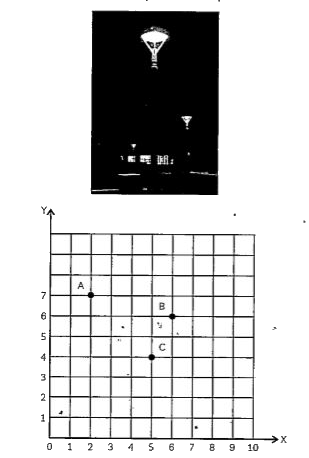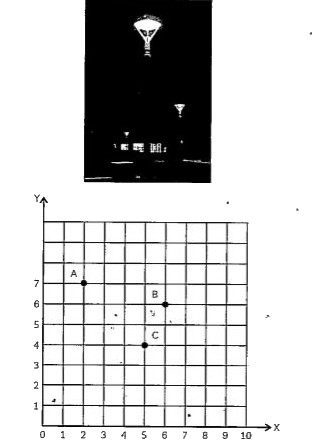Resident Welfare Association (RWA) of a M2 K Society in Azadpur have put up three electric poles A,B and C in a society 's common park near Tower A . Despite these poles ,some parts of the park are still in dark. So , RWA decides to have one more electron pole D in the park.

The position of the pole C is :
(5,4)
(2,7)
(8,9)
(9,8)
Step by step video & image solution for Resident Welfare Association (RWA) of a M2 K Society in Azadpur have put up three electric poles A,B and C in a society 's common park near Tower A . Despite these poles ,some parts of the park are still in dark. So , RWA decides to have one more electron pole D in the park. The position of the pole C is : by Maths experts to help you in doubts & scoring excellent marks in Class 10 exams.
Updated on:21/07/2023Topper's Solved these Questions
Similar Questions
An amusement park ride consist of a large verticle cylinder that spins about its axis first fast enough that any person inside is held up againest the wall when the is μs and the radius of the cylider is R

a. Shown that maximum period of revolation neccessary to keep the person from falling is T=(4π2μs/g)1/2
b. Obtain a numerical value for taking R=4.00m and μs=0.400 . How many revolations per minute does the cylinder make?
c.If the rate of revolation of the cylinder is make to be some what larger what happens to the magnitude of each one of the forces acting on the person ? What happens to the motion of the person ?
d.If instead the cylinder rate revolation is made to be somewhat smaller what happens to the magnitude happens to the motion of the person ?
View SolutionTwo skaters each of mass 50kg, approach each other along parallel paths separated by 3m. They have equal ad opposite velocities of 10m/s. The first skater carries a long light pole, 3m long, and the second skater grabs the end of it as he passes (assume frictionless ice).
a. Described quantitatively the motion of the skaters after they are connected by the pole.
b. By pulling on the skaters reduce their distance to 1m. What is their motion then?
c. Compare the KEs of the system in parts a. and b. where does the change come from?
View Solution
Knowledge Check
Resident Welfare Association (RWA) of a M2 K Society in Azadpur have put up three electric poles A,B and C in a society 's common park near Tower A . Despite these poles ,some parts of the park are still in dark. So , RWA decides to have one more electron pole D in the park.

The position of the fourth pole D so that four points A,B,C and D form a parallelogram is :A(1,4)B(1,5)C(2,3)D(5,1)Resident Welfare Association (RWA) of a M2 K Society in Azadpur have put up three electric poles A,B and C in a society 's common park near Tower A . Despite these poles ,some parts of the park are still in dark. So , RWA decides to have one more electron pole D in the park.

The distance of the pole B from the corner O of the park is :A√53 unitsB√41 unitsC√72 unitsD√145 unitsResident Welfare Association (RWA) of a M2 K Society in Azadpur have put up three electric poles A,B and C in a society 's common park near Tower A . Despite these poles ,some parts of the park are still in dark. So , RWA decides to have one more electron pole D in the park.

On the basis of the above information ,answer any four of the following questions :
The distance between poles A and C is :A√18 unitsB√17 unitsC√5 unitsD√34 units
An a.c. generator consists of a coil of 50 turns and area 2.5m2 rotating att an angular speed of 60rads−1 in a uniform magnetic field B = 0.3 T between two fixed pole pieces. The resistance of the circuit including that of coil is 500Ω. Find (i) the max. current drawn from the generator.
(ii) What will be the orientaiton of the coil w.r.t. the magnetic field to have (a) maximum (b) zero magnetic flux ?
(iii) Would the generator work if the coil were stationary and instead, the pole pieces rotated together with the same speed as above ?
View SolutionResident Welfare Association (RWA) of a M2 K Society in Azadpur have put up three electric poles A,B and C in a society 's common park near Tower A . Despite these poles ,some parts of the park are still in dark. So , RWA decides to have one more electron pole D in the park.

Plot a point D so that ABCD becomes parallelogram .The distance between poles B and D is :
View SolutionCO2 and H2O absorbs strongly in the infrared rrgion and its presence in the atmospheere dectrases the loss fo heat form the enrth by radistiion . This global warming is called the greenhouse effect (other gases , including the oxides of nitraongen form car exhauset freons from aerosols and refrigeratirs and methane from bacteria in the soil and in the rument cows , also add to the reeenhouse effect ). The concentration fo atmospheric CO2 has increased by 10% . The is rsulting in the increase in the mean temperature fo the earth by 2.5∘C, varying form 2∘C t the equlator to 4∘C at the poles . This could have dramatic effects on the climate.
As a result of freenhouse effect , thers can be :
A: an increase in rate of egvaporation of water thus, untimely more rain , floodingn tec .
B: tropical storms in certain parts of the workd
C: a decrease in pH of the soil
D: an increase in pH of the soil
select correct altemate :
View SolutionRead the passage carefully and choose the best answer to each question out of the four alternatives.
There may be some merit in this, but clearly, we need to look at the hawkers issue more broadly. For quite some time now, many middle-class citizens groups have urged strict action against hawkers, asking residents not to favour their business. The terms routinely used to refer to hawkers and vendors is “menace”, with their everyday businesses described as “encroachments” on public space. This, despite the fact that an existing 2014 central law, the Street Vendors (Protection of Livelihood and Regulation of Street Vending) Act, protects their presence as a part of the right to livelihood. The law specifies the number of licensed hawkers permitted and outlines the process to implement a fair street vending policy. Mumbai and other cities have failed to implement the law to date, with the Mumbai municipality having frozen hawker licenses since 1978. As a result, only a fraction of Mumbai’s hawkers are licensed. Hawkers desire legal status — their illegality makes them vulnerable to extortion and harassment by a whole range of State and non-State actors.
Unfortunately, by looking upon the hawkers question as only a clearing of pavements issue, we have neglected to see their contribution in several other ways. Firstly, hawkers are not the only ones sullying our pavements. But they are far easier to target as villains than the middle-class who use pavements for car parking and shops/restaurants who unabashedly extend their shopfronts onto footpaths. Secondly, hawking is also an employment issue. It provides the urban poor a means to earn a legitimate livelihood, and in fact, many sell goods produced in small-scale or home-based industries.
Why do only a small number of Mumbai’s hawkers have licenses?
View SolutionRead the passage carefully and select the best answer to question out of the given four alternatives.
PASSAGE - II
There may be some merit in this, but clearly, we need to look at the hawkers. issue more broadly. For quite some time now, many middle-class citizens groups have urged strict action against hawkers, asking residents not to favour their business. The terms routinely used to refer to hawkers and vendors is "menace", with their everyday businesses described as "encroachments” on public space. This, despite the fact that an existing 2014 central law, the Street Vendors (Protection of Livelihood and Regulation of Street Vending) Act, protects their presence as a part of the right to livelihood. The law specifies the number of licensed hawkers permitted and outlines the process to implement a fair street vending policy. Mumbai and other cities have failed to implement the law to date, with the Mumbai municipality having frozen hawker licenses since 1978. As a result, only a fraction of Mumbai.s hawkers are licensed. Hawkers desire legal status - their illegality makes them vulnerable to extortion and harassment by a whole range of State and non-State actors.
Unfortunately, by looking upon the hawkers. question as only a clearing of pavements issue, we have neglected to see their contribution in several other ways. Firstly, hawkers are not the only ones sullying our pavements. But they are far easier to target as villains than the middle-class who use pavements for car parking and shops/restaurants who unabashedly extend their shopfronts onto footpaths. Secondly, hawking is also an employment issue. It provides the urban poor a means to earn a legitimate livelihood, and in fact, many sell goods produced in small-scale or home-based industries.
Why do only a small number of Mumbai.s hawkers have licenses?
View Solution
